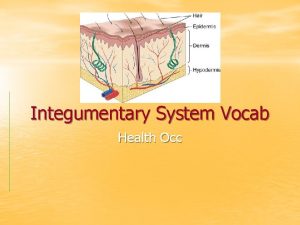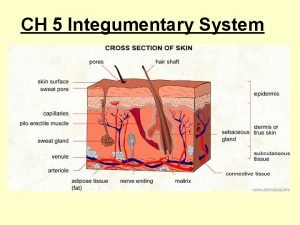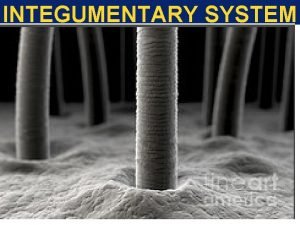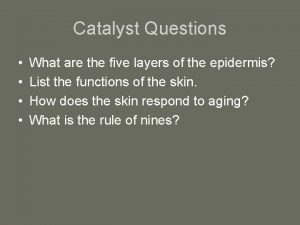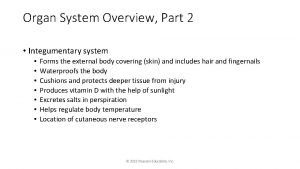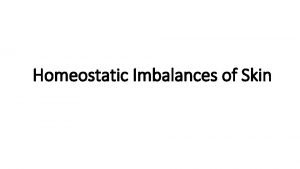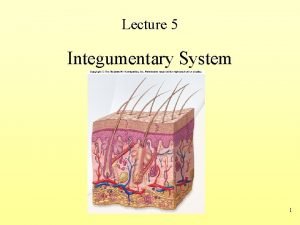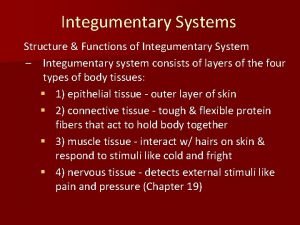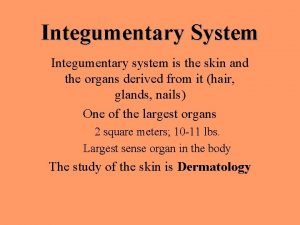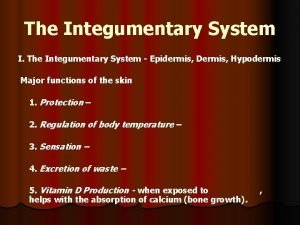Chapter 5 Integumentary System 1 Integumentary System Consists





























- Slides: 29

Chapter 5 Integumentary System 1

Integumentary System • Consists of: – – Skin Hair Nails Glands Integument means “covering” • Functions – Protection – Sensation (sensory receptors detect heat, cold, touch, pressure, pain) – Temperature regulation – Vitamin D production – Excretion 2

Hypodermis • Skin rests on this, but not a part • Attaches skin to underlying muscle; supplies it with blood vessels, nerves • Consists of loose connective tissue and fat • Types of cells – Fibroblasts – Adipose cells – Macrophages Thickens markedly when one gains weight • Also called: – Subcutaneous tissue – Superficial fascia 3

2 Major Layers Skin • Dermis – Strong, flexible connective tissue layer attached to hypodermis – Structural strength – Two layers • Reticular: Cleavage lines • Papillary: Blood vessels, Fingerprints • Epidermis – Layer of thick, keratinized stratified squamous epithelium that rests on dermis – 4 Cell types – 5 Layers or strata – Avascular 4

Dermis and Epidermis 5

Epidermal Cells • Cell types – Keratinocytes: Produce keratin for strength and permeability – Melanocytes: Contribute to skin color – Langerhans’ cells: Part of the immune system – Merkel’s cells: Detect light touch and light pressure • Desquamate: Older cells at surface slough off • Keratinization: – Cells move from deeper layers to surface, change shape and become filled with keratin – Produces outer layer that resists abrasion and forms permeability layer 6

Epidermal Strata • 5 Strata, from deepest to most superficial: • Stratum Basale – Deepest portion of epidermis; single layer of cuboidal or columnar cells representing the youngest keratinocytes – High mitotic activity – Melanocytes (10 -25% of cells in this layer) produce melanin • Stratum Spinosum – Limited mitosis – Keratin fibers and lamellar bodies accumulate – Together with stratum basale, often called stratum germinativum 7

Epidermal Strata (cont’d) • Stratum Granulosum – Keratohyalin granules accumulate in cell – Lamellar bodies release lipids; cells die • Stratum Lucidum – Thin, clear zone; appears translucent – Consists of several layers of dead cells – Only present in a few areas of body • Stratum Corneum – Most superficial; consists of cornified cells – 25 or more layers of dead squamous cells (dandruff, flaky dry skin) Millions of dead keratinocytes rub off daily, giving us totally new epidermis every 25 -45 days 8

Epidermal Layers and Keratinization 9

Melanin Transfer from Melanocyte to Keratinocytes 10

Thick and Thin Skin • Refers to epidermis only; not total skin thickness (which is measured by a thickness in the dermis) • Thick skin – Has all 5 epithelial strata – Stratum corneum has many layers of dead cells – Found in areas subject to pressure or friction • Palms of hands, fingertips, soles of feet • Thin skin – – More flexible than thick skin Stratum lucidum absent; other 4 strata are thinner Covers rest of body Where hair is found 11

Skin Color • Determined by 3 factors: – Pigments • Melanin: Provides for protection against UV light • Albinism: Deficiency or absence of pigment • Carotene: Yellow pigment from carrots, corn – Blood circulating through the skin • Imparts reddish hue and increases during blushing, anger, inflammation, fever, hypertension, allergy • Cyanosis: Blue color caused by decrease in blood oxygen content – Thickness of Stratum Corneum Freckles, pigmented moles: local accumulations of melanin 12

13

Accessory Skin Structures • Hair – Found everywhere on human skin except palms, soles, lips, nipples, parts of external genitalia, and distal segments of fingers and toes – Lanugo, terminal hairs, vellus hairs • Glands – – Sebaceous or oil glands Sudoriferous or sweat glands Ceruminous glands or earwax glands Mammary glands • Nails 14

Hair Structure • Composed of shaft and root – Shaft protrudes above skin surface – Root located below surface and base forms the hair bulb • Has 3 concentric layers of dead keratinized epithelium – Medulla: Central axis – Cortex: Forms bulk of hair – Cuticle: Forms hair surface 15

16

Hair Growth, Color, and Muscles • Hair Growth – Cycles • Growth stage and resting stage – Growth stage-hair is formed by cells of the matrix differentiating, become keratinized and die; hair grows longer as cells add to base of hair root – Resting stage-then new cycle begins; new hair replaces old hair • Hair growth varies depending on location (average 0. 3 mm/day) – Eyelashes grow for 30 days, rest for 105; scalp hair grows for 3 years, rests for 1 -2 years – Permanent hair loss • Pattern baldness most common • Hair follicles lost; remaining produce vellus hair 17

Hair Growth, Color, and Muscles (cont’d) • Hair Color – – – Caused by varying amounts and types of melanin Blonde hair: little black-brown melanin Black hair: most melanin Brown hair: intermediate amounts of melanin Red hair: varying amounts of red melanin Gray or white hair: with age, melanin decreases • Muscles – Arrector pili: • Smooth muscle cells associated with each hair follicle • Muscle contraction causes hair to “stand on end”; the raised hair follicles are called “goose bumps” 18

Oil and Sweat Glands • Sebaceous glands – Holocrine glands located in dermis – Produce sebum – Oils hair and skin surface • Sudoriferous glands – Merocrine sweat glands • Most common • Open directly onto skin through pores • Numerous in palms and soles – Apocrine sweat glands • Open into hair follicle • Found in axillae, genitalia, around anus • Cause body odor 19

OTHER GLANDS • Ceruminous glands: • modified merocrine sweat glands in the ear canal • produce cerumen (earwax) • cerumen+ hairs protect eardrum; prevent dirt and small insects from entering ears • Mammary glands: • modified apocrine sweat glands in breast • part of female reproductive system • milk production 20

Nails • Anatomy – Nail is stratum corneum with hard keratin – Nail root proximally – Nail body distally – Eponychium or cuticle – Nail matrix: produces the nail • Growth – Grow continuously (unlike hair) at an average rate of 0. 51. 2 mm per day) – Grow from base, like hair The distal end of primate digits have nails 21

Summary of Integumentary System Functions 1. Stratified squamous epithelium of skin protects against abrasion 2. Prevents entry of microorganisms and other harmful substances into the body. Contains components of the immune system that protects against microbes 3. Melanin absorbs ultraviolet light and protects underlying structures 4. Hair protection: heat insulator; protection against ultraviolet light and abrasion; eyebrows keep sweat out of the eyes; eyelashes protect eyes from foreign objects; nose and ear hairs prevent entry of dust and other materials. 5. Nails protect the ends of digits. 6. Prevents water loss-lipids prevent diffusion of lipids 22

Sensation • Sensory receptors in all layers detect pain, heat and cold • Epidermis and dermal papillae: touch receptors • Dermis, deeper tissues: pain, heat, cold, touch, pressure receptors • Hair follicles (but not hair): well innervated; sensory receptors near base of hair follicles sense hair movement Temperature Regulation • Maintain homeostasis • To cool off: blood vessels in dermis dilate (vasodilate); more blood flows close to surface; heat given off as perspiration • To retain heat: blood vessels in dermis constrict (vasoconstriction); reduces surface blood flow and heat loss 23

Vitamin D Production • Functions as a hormone • stimulates uptake of calcium(Ca) and phosphate(P) from small intestines • promotes their release from bones • reduces Ca loss from kidneys; resulting in increased blood Ca/P needed for normal bone metabolism Ca needed for normal nerve and muscle function üVitamin D synthesis begins in the skin in response to ultraviolet light; • precursor molecule 7 -dehydrocholesterol; • converted to cholecalciferol by UV light: released into the blood • modified in liver and kidneys to active vitamin D (calcitriol) • Can also be ingested and absorbed by intestines: liver, egg yolks, dairy products, 24 fortified milk, vitamin pills

Excretion • Removal of waste products from the body • Perspiration (sweat): water+ salts+ small amounts of waste products (urea, uric acid, ammonia) 25

Aging Effects • Skin more easily damaged; slower repair • Epidermis thins; decrease of collagen in dermis • Skin becomes drier • Sebaceous gland activity decreases • Skin sags and wrinkles • Loss of fat from hypodermis; decrease in elastic fibers in dermis • Functioning melanocytes decrease, but increase on hands and face as age spots • Sunlight ages skin more rapidly 26

The Rule of Nines 27 Surface area estimations

Burns Classifications • Partial thickness burns – First-degree: epidermis only; red, painful and edema(swelling); sunburn, brief exposure to hot objects; heal in a week; no scar tissue – Second-degree: epidermis and dermis; red, pain, edema and blisters; heal in 2 weeks; deep dermis-several months to heal; scar tissue may appear • Full thickness burns – Third-degree: epidermis and dermis destroyed; no pain; varying colors; loss of functions of the integumentary system • Skin Grafts – Split skin – Artificial skin – Cadavers or pigs 28

Clinical Disorders of the Skin • Bacterial Infections – Acne, impetigo • Viral Infections – Chicken pox, German measles, cold sores, warts • Fungal Infections – Ringworm, athlete’s foot, jock itch • Cancer – Basal cell carcinoma (most common; least malignant) – Squamous cell carcinoma (may metastasize) – Malignant melanoma (will metastasize-starts from mole; spreads to other body sites) 29
 Unit 3 integumentary system
Unit 3 integumentary system Chapter 6 integumentary system
Chapter 6 integumentary system Chapter 36 skeletal muscular and integumentary systems
Chapter 36 skeletal muscular and integumentary systems Glands in integumentary system
Glands in integumentary system Integumentary system vocabulary
Integumentary system vocabulary Integumentary system of pig
Integumentary system of pig Definisi sistem integumen
Definisi sistem integumen Integumentary system facts
Integumentary system facts Exercise 7 the integumentary system
Exercise 7 the integumentary system Integumentary system abbreviations
Integumentary system abbreviations Integumentary system medical terminology
Integumentary system medical terminology Integumentary system
Integumentary system Integumentary system physical examination
Integumentary system physical examination Integumentary system analogy
Integumentary system analogy The integumentary system
The integumentary system The integumentary system
The integumentary system Integumentary system components
Integumentary system components Integumentary system effects of aging
Integumentary system effects of aging Section 36-3 the integumentary system
Section 36-3 the integumentary system Integumentary system
Integumentary system Integumentary system
Integumentary system Homeostatic imbalances
Homeostatic imbalances Cells in stratum spinosum
Cells in stratum spinosum 6 functions of the integumentary system
6 functions of the integumentary system Anatomy and physiology of psoriasis
Anatomy and physiology of psoriasis Interesting facts about the integumentary system
Interesting facts about the integumentary system Integumentary system
Integumentary system Integumentary system
Integumentary system Integumentary system cpt coding guidelines ppt
Integumentary system cpt coding guidelines ppt Contains several layers of polygonal keratinocytes
Contains several layers of polygonal keratinocytes









